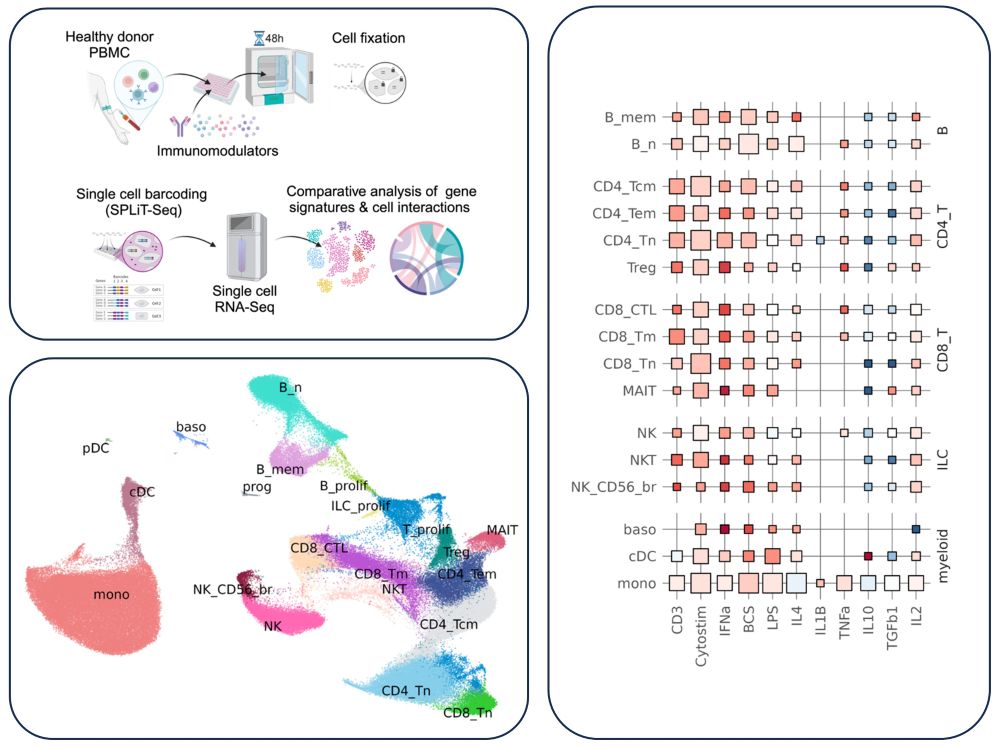
Adam Braithwaite
@braithwaiteat.bsky.social
Senior Scientist, Bioinformatics @ Gilead Sciences | Bioinformatics | Computational biology | Fibrosis | Immunology | Cardiovascular disease
https://scholar.google.co.uk/citations?hl=en&user=QgA-ngcAAAAJ&view_op=list_works&sortby=pubdate
https://scholar.google.co.uk/citations?hl=en&user=QgA-ngcAAAAJ&view_op=list_works&sortby=pubdate
Pinned

Stimulating immune cells in vitro is a common experimental lab model. We profiled 150K blood immune cells treated with 11 different stimuli to compare the effects. The data are freely available for researchers. See the preprint for our findings and to access the data 🧪 doi.org/10.1101/2025...
Reposted by Adam Braithwaite
🧬 Sharing an exciting new pre-print from the team! We stimulated healthy blood cells with 11 different treatments used in immunology research & created single-cell profiles to compare responses. Hopefully an invaluable resource for immunology/disease researchers 📖 www.biorxiv.org/content/10.1...
Intra- and intercellular immune responses across diverse in vitro stimuli and inflammatory disease
In vitro stimulation of healthy human immune cells is commonly used to reproduce the immune states observed in disease, both to understand pathology and to test therapeutic approaches. However, experiments typically focus on individual cell types and stimuli and a comprehensive cellular comparison of common immunomodulators and their relevance to disease is lacking. To this end, we performed integrated single-cell transcriptomic profiling of human peripheral blood mononuclear cells treated with 11 different common in vitro stimuli, totalling over 150,000 cells from 21 immune cell subtypes. Comparative analysis of the immunomodulations revealed their shared and unique pathways, for instance stimulation via the T cell receptor (anti-CD3, CytoStimTM) and IFN-α induced broad activation signatures including off-target effects across multiple cell types, whereas TNF-α and LPS elicited more specific responses. Ligand-receptor interaction mapping also uncovered the common and distinct intercellular signalling pathways across stimuli. Comparing the stimuli to patient samples enabled identification of specific inflammatory disease features best replicated by each. For example, IFN-α stimulation recapitulated signatures of SLE across cell types, whereas LPS induced SLE-like changes specifically within monocytes. Comparative cell-cell network analysis showed that in vitro stimuli were able to recreate some, but not all, aspects of intercellular interactions upregulated in SLE, highlighting the limitations of these model systems. This resource provides new insights into the similarities and differences of established immune stimuli at cellular resolution and facilitates appropriate use of in vitro systems to study pathways relevant to disease. ### Competing Interest Statement The authors have declared no competing interest.
www.biorxiv.org
July 7, 2025 at 1:35 PM
🧬 Sharing an exciting new pre-print from the team! We stimulated healthy blood cells with 11 different treatments used in immunology research & created single-cell profiles to compare responses. Hopefully an invaluable resource for immunology/disease researchers 📖 www.biorxiv.org/content/10.1...
Stimulating immune cells in vitro is a common experimental lab model. We profiled 150K blood immune cells treated with 11 different stimuli to compare the effects. The data are freely available for researchers. See the preprint for our findings and to access the data 🧪 doi.org/10.1101/2025...

July 3, 2025 at 3:39 PM
Stimulating immune cells in vitro is a common experimental lab model. We profiled 150K blood immune cells treated with 11 different stimuli to compare the effects. The data are freely available for researchers. See the preprint for our findings and to access the data 🧪 doi.org/10.1101/2025...
Reposted by Adam Braithwaite
Intra- and intercellular immune responses across diverse in vitro stimuli and inflammatory disease https://www.biorxiv.org/content/10.1101/2025.06.27.661918v1
July 2, 2025 at 5:15 PM
Intra- and intercellular immune responses across diverse in vitro stimuli and inflammatory disease https://www.biorxiv.org/content/10.1101/2025.06.27.661918v1
Reposted by Adam Braithwaite
Intra- and intercellular immune responses across diverse in vitro stimuli and inflammatory disease https://www.biorxiv.org/content/10.1101/2025.06.27.661918v1
July 2, 2025 at 5:16 PM
Intra- and intercellular immune responses across diverse in vitro stimuli and inflammatory disease https://www.biorxiv.org/content/10.1101/2025.06.27.661918v1

